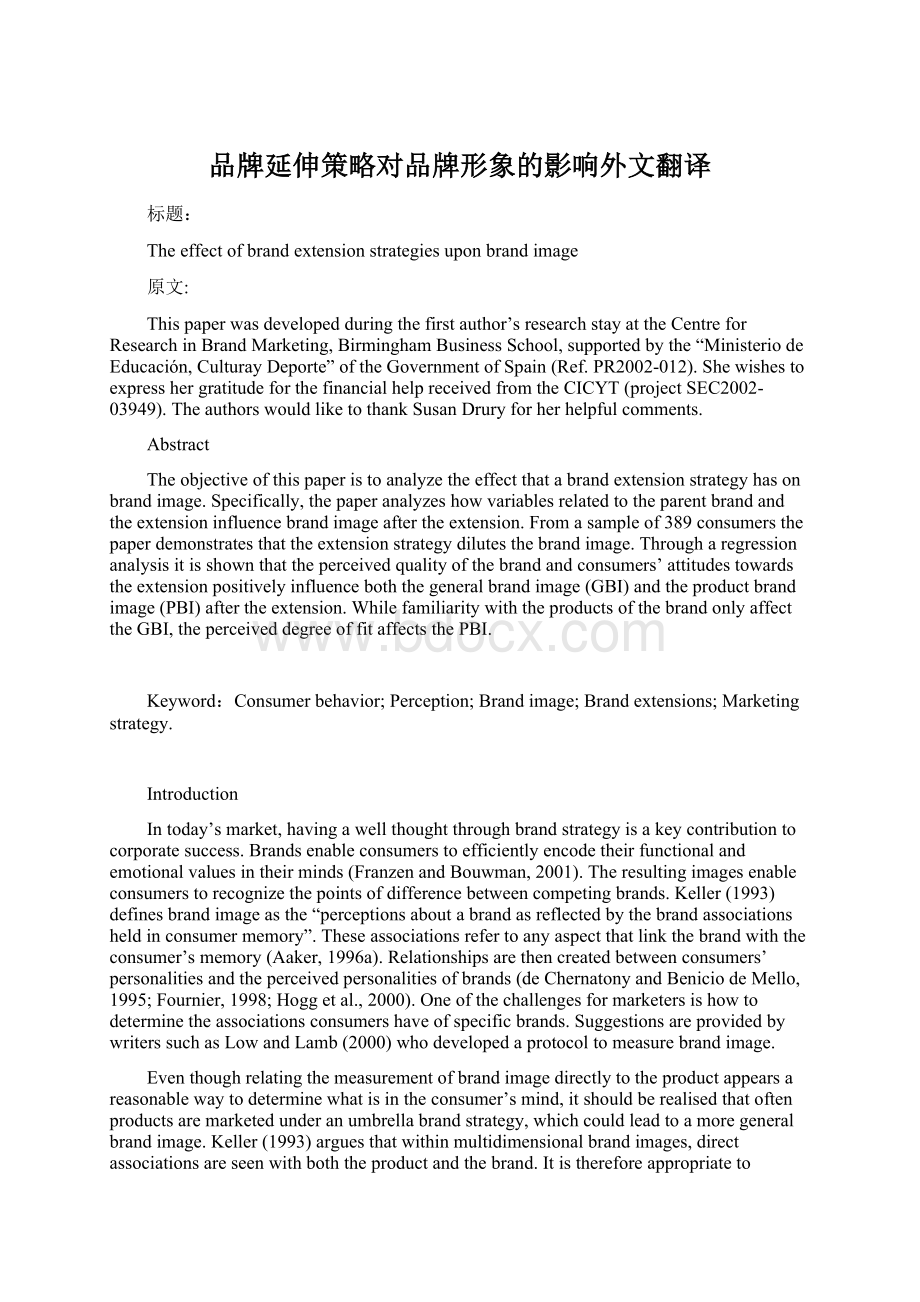品牌延伸策略对品牌形象的影响外文翻译.docx
《品牌延伸策略对品牌形象的影响外文翻译.docx》由会员分享,可在线阅读,更多相关《品牌延伸策略对品牌形象的影响外文翻译.docx(7页珍藏版)》请在冰豆网上搜索。

品牌延伸策略对品牌形象的影响外文翻译
标题:
Theeffectofbrandextensionstrategiesuponbrandimage
原文:
Thispaperwasdevelopedduringthefirstauthor’sresearchstayattheCentreforResearchinBrandMarketing,BirminghamBusinessSchool,supportedbythe“MinisteriodeEducación,CulturayDeporte”oftheGovernmentofSpain(Ref.PR2002-012).ShewishestoexpresshergratitudeforthefinancialhelpreceivedfromtheCICYT(projectSEC2002-03949).TheauthorswouldliketothankSusanDruryforherhelpfulcomments.
Abstract
Theobjectiveofthispaperistoanalyzetheeffectthatabrandextensionstrategyhasonbrandimage.Specifically,thepaperanalyzeshowvariablesrelatedtotheparentbrandandtheextensioninfluencebrandimageaftertheextension.Fromasampleof389consumersthepaperdemonstratesthattheextensionstrategydilutesthebrandimage.Througharegressionanalysisitisshownthattheperceivedqualityofthebrandandconsumers’attitudestowardstheextensionpositivelyinfluenceboththegeneralbrandimage(GBI)andtheproductbrandimage(PBI)aftertheextension.WhilefamiliaritywiththeproductsofthebrandonlyaffecttheGBI,theperceiveddegreeoffitaffectsthePBI.
Keyword:
Consumerbehavior;Perception;Brandimage;Brandextensions;Marketingstrategy.
Introduction
Intoday’smarket,havingawellthoughtthroughbrandstrategyisakeycontributiontocorporatesuccess.Brandsenableconsumerstoefficientlyencodetheirfunctionalandemotionalvaluesintheirminds(FranzenandBouwman,2001).Theresultingimagesenableconsumerstorecognizethepointsofdifferencebetweencompetingbrands.Keller(1993)definesbrandimageasthe“perceptionsaboutabrandasreflectedbythebrandassociationsheldinconsumermemory”.Theseassociationsrefertoanyaspectthatlinkthebrandwiththeconsumer’smemory(Aaker,1996a).Relationshipsarethencreatedbetweenconsumers’personalitiesandtheperceivedpersonalitiesofbrands(deChernatonyandBeniciodeMello,1995;Fournier,1998;Hogg etal.,2000).Oneofthechallengesformarketersishowtodeterminetheassociationsconsumershaveofspecificbrands.SuggestionsareprovidedbywriterssuchasLowandLamb(2000)whodevelopedaprotocoltomeasurebrandimage.
Eventhoughrelatingthemeasurementofbrandimagedirectlytotheproductappearsareasonablewaytodeterminewhatisintheconsumer’smind,itshouldberealisedthatoftenproductsaremarketedunderanumbrellabrandstrategy,whichcouldleadtoamoregeneralbrandimage.Keller(1993)arguesthatwithinmultidimensionalbrandimages,directassociationsareseenwithboththeproductandthebrand.Itisthereforeappropriatetoconsideramethodformeasuringthedimensionsofabrand’simagethatcanbeusedforvariousproductcategoriesandvariousbrands(Aaker,1996b).
Whenstudyingabrand’simageitshouldberealizedthatthisisnotstaticandisinfluencedbythenumerousdecisionsthatthecompanytakesaboutitsbrandovertime.Afrequentlyadoptedstrategyisthatofbrandextension.Thereareseveralreasonsforthepopularityofbrandextensionstrategies.Forexample,thecostoflaunchinganewbrandinconsumermarketsisveryhigh(PittaandKatsanis,1995),andtheprobabilityofthesuccessforanewproductishigherwithawell-knownparentbrand(Aaker,1991).
Withthepopularityofbrandextensions,thereisnotableliteratureonthesubjectexploringhowconsumersbehaveasaresultofdifferentbrandextensions.Specifically,attentionhasfocusedonhowdifferentvariablesrelatedtotheparentbrand(e.g.brandquality,brandreputation,brandbreadth,familiarity,etc.)andtheextensionconsideredinfluenceconsumers.Themajorityofstudieshaveconsideredthoseaspectsthatincreasethesuccessofabrandextension.However,somestudieshavebeenconcernedwiththenegativeeffectthatthenewlyextendedbrandmayhaveontheparentbrand(LokenandJohn,1993;Gürhan-CanliandMaheswaran,1998;John etal.,1998).
Themajorityofstudiesintheliteratureconsiderperceptionswhenevaluatingthevariablesthatcanhaveapositiveornegativeinfluenceontheextension,aswellasattitudestowardstheextendedbrand.Furthermorethemajorityofstudiesarebasedonexperimentationwithgroupsofstudents.Exceptionstothisareseenwhenthedatahasbeenobtainedfrommarketsurvey(DacinandSmith,1994;ParkandKim,2001;Gronhaug etal.,2002;Hem etal.,2003),orfrompaneldata(Reddy etal.,1994;Swaminatham etal.,2001),orexperimentationwithsamplesreflectingspecificaspectsofbrandsbeingstudied(LokenandJohn,1993;John etal.,1998).Someofthesestudieshaveallowedresearcherstoinvestigatedifferentkindsofbrands(realandfictitious)acrossabroadrangeofextensions,therebyallowingtheanalysisofthejointeffectofdifferentvariables.Nevertheless,thistechniquehasreceivedcriticismfromsomeauthorsbecauseoftheexternalvalidityproblems(KindandSmith,2001)andtheoccasionaluseofhypotheticalbrandsortheforcingofaresponseinagroupenvironment(Swaminatham etal.,2001).
Thereisagapintheliteratureinsofarastheeffectofbrandextensionsonbrandimagehasreceivedlittleattention.Wesoughttoadvanceknowledgebyinvestigatingthis.Startingfromthepremisethatabrand’simageisbasedontheassociationsthatconsumershavewiththebrand,weinvestigatedhowtheconsumer’sperceptionofbrandvariables,andtheextensionitself,affectabrand’simage.Ourconcernwastounderstandtheextenttowhichcertainbrandextensionstrategiescarrymoreriskthanothers.Ourobjectiveswereto:
Determinethechangethatoccurstoabrand’simageasaresultofabrandextensionstrategy.Weinvestigatedthisusingtwodifferentmethods:
thegeneralbrandimagerelatedtothename(GBI)andthebrandimagerelateddirectlytotheproduct(PBI).
Studytheinfluenceofspecificvariablesontheimageaftertheextensionusingtheabovetwomeasurementmethods.Thevariablesincludedare:
thequalityoftheparentbrand,knowledgeorfamiliaritywiththebrand,thefitorsimilaritybetweenthebrandandtheextension,andattitudestowardstheextendedproduct.
Conceptualbackgroundandhypothesis
Brandimagerelevance
Withinthetwoperspectives,corporationandconsumers,fromwhichthebrandcanbedefined(deChernatonyandDall’Olmo,1997;1998)emergetwokeyconcepts:
brandidentityandbrandimage.AakerandJoachismsthaler(2000)definebrandidentity“asetofbrandassociationsthatthebrandstrategistaspirestocreateormaintain”.Brandidentityhastoconsidermultipleaspects,suchasthedesiredpositioningandthepersonality(deChernatony,1999),whichareattenuatedbytheorganizationalcultureandtherelationshipsstaffbuildwithstakeholders.Facilitatedbycommunicationmechanisms(Kapferer,1997),thebrandidentityformsassociationsintheconsumer’smindresultinginabrandimage.Bothconceptsareinterrelatedandthroughassessingthecongruencebetweenbrandidentityandimagethisenablescorporationstorefinetheirbrandstrategy(vanRekom,1997;Haynes etal.,1999).
Theextantliteratureshowsthatbrandimageisamulti-dimensionalconcept,butthereisnoconsensusonhowtoempiricallymeasureit.Keller(1993),whenposingatheoreticalmethodformeasuringbrandequity,observesthatbrandimageincludedassociationsrelatedtotheproduct(attributes,benefitsandattitudes),favorabilityofbrandassociations,strengthofbrandassociations,anduniquenessofbrandassociations,developedascaleformeasuringconsumerbasedbrandequity,inwhichtheyrefertotheimagedimensionasthesocialimage,whichisunderstoodas“theconsumer’sperceptionoftheesteeminwhichtheconsumer’ssocialgroupholdsthebrand”.Withinthethemeofbrandequity,Aaker(1996b)proposesthatbrandimagebemeasuredthroughassociation/differentiationmeasuresregardingvalue,brandpersonality,organizationalassociations,anddifferentiation.Aaker’sapproachcanbeusedforbrandsindifferentproductcategories,enablingustotalkaboutageneralbrandimagerelatedfundamentallytothebrandname.
Thereisastreamofliteraturethatregardsbrandimageasbeingdirectlyrelatedtotheproductcategorywithinwhichthebrandismarketed.LowandLamb(2000)arguethatwithinbrandassociationstherearethreemultidimensionalandinterrelatedconcepts,i.e.brandimage,perceivedqualityandbrandattitude.Theycreatedaprotocolformeasuringbrandimagebasedontheproductcategory.Measuringbrandimage,basedonproductcategory,hasbeenusedindifferentwaysinrecentstudies(GwinnerandEaton,1999;Hoggetal.,2000;Faircloth etal.,2001;Hsieh,2002).However,thesealwayshavetakenintoaccountthatnotonlymustthephysicalattributesoftheproductsbeconsidered,butalsothefunctional,emotionalandself-expressivebenefits(Davis,2002;Vázquez etal.,2002).Thismethodofmeasuringbrandimageprovidesuswithwhatwerefertoasproductbrandimage.
Notallcompanieshavethesameopportunitiestoextendtheirbrands,asitisconditionalontheirhistoricalbrandstrategies(MihailovicanddeChernatony,1994;Milberg etal.,1997;AakerandJoachimsthaler,2000;DesaiandKeller,2002).Nevertheless,iftheydecidetolaunchanewproduct,aspartofabrandextensionstrategy,achangeofbrandimagewilloccurwithnewassociationscreatedinconsumers’minds.Thismaydilutefeelingsandbeliefsconsumersholdabouttheparentbrand(RiesandTrout,1986;Sharp,1993).Eventhoughtheassociationsforthenewproductmaybepositive,negativeassociationsmightbecreatedthatadverselyaffectthebrandimage(PittaandKatsanis,1995;Chen